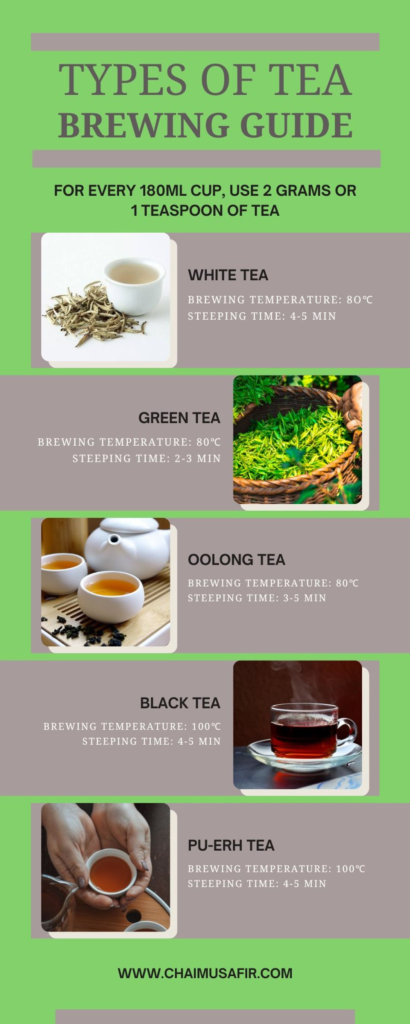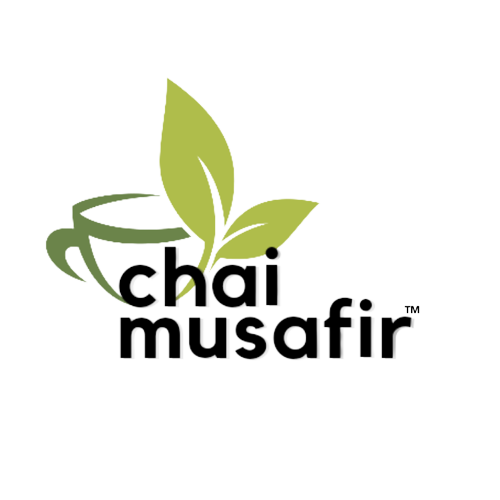

The World of Tea: A Comprehensive Guide to Becoming a Tea Connoisseur
What is Tea and What are the Different Types of Teas?
Tea is a beverage that has been around for centuries, enjoyed by people all over the world. There are many different types of teas, each with its own unique flavor and health benefits. Green tea, black tea, oolong tea, white tea and herbal tea blends are some of the most popular varieties. All tea types (not the herbal tisanes or Rooibos) come from the same “tea plant” species, Camellia sinensis. What differentiates the various types of teas is how they are processed, including the degree of oxidation.
Each type of tea has its own distinct flavor profile and can be enjoyed both hot and cold. Teas also have various health benefits such as aiding in weight loss, reducing inflammation and helping to improve mental clarity. Let us know look at the tea types that come from Camellia Sinensis.
White Tea: White tea is known to be one of the most delicate tea varieties because it is usually the least processed. It is usually made from the leaf buds that are covered in white downy hair and plucked prior to opening. This type of white tea is called Silver Needle and is one of the most expensive white teas in the market. There are also other types of white teas from China and India such as the Pai Mu Tan which are made with two leaves and a bud. These teas have a slightly stronger flavor than the silver needle.
Following a process of wilting, baking, rolling & drying, white tea is unoxidized, has a very delicate flavor and is slightly sweet to taste.


Yellow Tea: This tea is produced only in China. Considered as a rare and expensive category of tea, it is usually made in small batches. The leaves are processed like green tea; however, they undergo a longer drying process which results in the leaves turning yellow, hence the name!
Green Tea: The main aim in the production of the tea is to preserve the natural yet fresh taste of the tea plant keeping all its qualities intact. There are thousands of varieties of the tea that are available in the market today. Some are even processed by adding natural scent from flowers like Jasmine. The Japanese form of green teas are very popular around the world such as the Sencha and Matcha green teas, while in Nepal the most popular variety is the roasted green tea that breaks the monotony by adding some crunchiness.
Oolong Tea: Oolong is derived from “Wulong” which means Black dragon in Chinese language. During processing the leaves are bruised in one of the steps, where the edges of the leaves start releasing oils and this starts the oxidation process. The level of oxidation can vary from 10-90% resulting in different types of Oolongs. Hence different varieties of Oolongs can vary in flavor profiles, from fresh floral to nutty and toasty, depending on the level of oxidation.
Black Tea: This is by far the tea that is the most produced and consumed variety. These are fully oxidized. The goal of black tea processing is to achieve a high level of oxidation according to the seasonal variation of the leaves. The commonly known CTC (Crushed, Tear, Curled) is also a variety of black tea.
Dark Tea: Dark teas are produced by the process of post-fermentation and aging processed tea. Micro-organisms play a pivotal role in the aging process. Puer is a type of Chinese dark tea. Produced in the Yunnan province of China, this tea is aged either naturally (Sheng or raw Puer) where the leaves are picked, sundried & compressed allowing a natural aging process or artificially (Shou Puer) where the picked, processed & partially fired & moist tea is piled & aged in controlled conditions. They both offer a unique flavor and aroma that can’t be found in other teas.
Another class of beverages not made from Camellia Sinensis is called herbal blends or tisanes.
This is a drink made by blending leaves, roots, bark, seeds or flowers of different plants. It is usually caffeine free and a relaxing beverage. Some popular examples of herbs are mint, ginger, chamomile, lavender etc.
A Look at the Different National and Regional Tea Industries Around the World
Tea is a popular drink around the world, and each region has its own unique tea industry. From Japan’s matcha to India’s masala chai, each region has its own distinct flavor of tea that reflects the culture and history of the area. In this section, we will take a look at some of the different national and regional tea industries around the world, including their production methods and tea types.
India is home to a rich and vibrant tea culture. India is one of the major players in the global tea market. With China being the top producer and consumer, India is a close second, producing and consuming a significant portion of the total global tea production. With an ever-increasing demand for Indian tea due to its unique flavor, aroma and quality, India has become an important player in this ever-growing industry.
Tea has been an integral part of Indian culture since the British colonial era. The drink has become a symbol of hospitality in India, and it is often shared as a sign of friendship and respect. Tea is consumed throughout the day in many different forms, such as masala chai, green tea, and even herbal infusions. It has been an important part of social gatherings for centuries, with people enjoying its flavor and health benefits. Tea is one of the most popular beverages in India, offering not only refreshment but also symbolic cultural significance. From the bustling street tea stalls of Mumbai to the tranquil mountain towns of Darjeeling, India’s tea culture is as vibrant and varied as its history.


Tea producers in India utilize a variety of production methods that range from traditional hand-picking techniques in tea gardens to more modern automated processes. There are a variety of different types of teas that have been developed over time, such as Darjeeling, Assam and Nilgiri teas.
Another interesting category of teas that you can find in India is called Wild Tea. To know more about wild teas, read here.
India also produces a type of post-fermented or aged tea called Bamboo Phalap smoked tea. This tea has been produced for hundreds of years by the Singpho tribe in Assam, India. To know more, click here.
You would also be excited to know about another form of tea consumed in some parts of India called Butter tea or Gur Gur cha. You can watch this video here to know more about it: Butter tea with Buddhist Monks
So, whether you are looking for a refreshing cup of chai or just want to learn more about India’s amazing cultural heritage, Indian tea can provide an unforgettable experience. With its rich history and diverse flavors, Indian tea is sure to be a treat for your taste buds!
Japan is renowned for its tea culture, which has been integral to the country’s cultural identity. The Japanese Tea Ceremony is an age-old tradition and special methods are used to cultivate different types of teas, demonstrating the nation’s deep-rooted history with it. People in Japan have enjoyed tea for centuries and continue to do so today.




The Japanese have a number of unique habits related to their tea consumption, such as drinking green tea with meals or using special utensils for brewing. There are also different types of teas produced in Japan, such as matcha, sencha, genmaicha and hojicha. These teas are grown in carefully maintained gardens that use traditional methods to produce high-quality teas.
In addition to its cultural significance, Japan’s tea culture has also become popular among tourists who visit the country in search of the perfect cup of tea. With its vast variety of flavors and styles, there is something for everyone when it comes to exploring Japan’s centuries-old tradition of tea drinking.
Tea has also played an integral role in the cultures of both China and Sri Lanka for many years. The Chinese have a strong relationship with tea that is seen through their customs and rituals that still hold to this day. Chinese tea producing regions are known for their unique and diverse flavors. Famous tea-producing regions like Yunnan, Fujian Province and Wuyi Rock Mountain Teas offer unique flavors. The flavor of the tea is determined by the climate, soil and production techniques employed in the area.


Yunnan is known for its black teas such as Pu-erh and Dian Hong. Fujian Province is home to some of the most popular oolong teas such as Tie Guan Yin and Da Hong Pao. Wuyi Rock Mountain Teas are renowned for their unique flavor profiles that come from the mineral-rich soils of the mountain range.
These Chinese tea producing regions have become increasingly important in recent years due to their high-quality teas that have been gaining popularity around the world. They offer a wide variety of flavors that can be enjoyed by tea lovers everywhere.
In Sri Lanka too, drinking tea has become a part of daily life for many people. The country is known for its high-quality Ceylon teas that are produced using traditional methods passed down through generations. People in Sri Lanka often drink their teas with milk or sugar to enhance the flavor even further. Whether it’s in China or in Sri Lanka, drinking a cup of hot or cold brewed tea is one way to relax and enjoy life.
There are many other tea growing regions in the world such as Argentina (known for its iced tea grade black teas), Georgia, Turkey and so on.
How to Become a Professional Tea Connoisseur? Tips & Tricks for Brewing Perfect Teas Every Time
Becoming a professional tea connoisseur is an exciting journey that requires dedication and hard work. It can be an incredibly rewarding experience for those who are passionate about the art of brewing tea. To become a professional tea connoisseur, you must learn the fundamentals of tea brewing and tasting. You must also understand the different types of teas and how to properly store them. Finally, you must develop your own unique style of brewing and tasting so that you can create perfect cups of tea every time.
Enhancing your skills and knowledge doesn’t have to be costly. Various free resources are available online that can take you from the basics to a more advanced level before you consider investing in prestigious certifications. Some of my favorite YouTube channels to learn about tea are:
But nothing teaches you better than practice and exposure. Hands-on experience is the best way to learn about tea. Take your time to explore the various types of tea from all over the world, and experiment with different brewing methods. This will help you gain an in-depth understanding of this delightful beverage.


Different types of teas require different brewing techniques to bring out their unique flavors and aromas. Brewing black tea is an art form that has been perfected over centuries. It requires a delicate balance of temperature, time, and technique to bring out the best flavor and aroma from the tea leaves. Different countries have their own unique brewing techniques for black teas, such as the gong fu ceremony in China and the traditional Indian method of boiling water with spices.
In Russia, the traditional method of brewing black tea involves using a samovar, which is a metal container with a spigot at the bottom. This method of brewing black tea is still popular today and can be seen in many Russian households. This involves boiling water in the samovar and then adding loose-leaf black tea to the boiling water. The mixture is then left to steep for several minutes before it is ready to be served. This method produces a strong, flavorful cup of black tea that has been enjoyed by Russians for centuries.
Following is a quick steeping guide for different types of teas. Feel free to experiment and see what works best for you.


Some of my favorite tips to brew the perfect cup of tea are:
1. Get a pocket weighing scale & a timer! This helps in easily measuring the tea leaves and the steeping time.
2. If you don’t have a temperature-controlled kettle, boil water & let it sit for a few minutes to reach the desired temperature and even better if you get a food thermometer to keep a check on the same! Try it a few times and see what works as the ambient temperature affects the sitting time as well.
3. To make sure your tea stays warm for longer periods, it is advisable to pre-warm the teacups and teapot before making and serving the tea.
4. Use an extra spoon of tea for the teapot. This makes a lot of difference in the final result, trust me!
I hope this article helps you start your tea adventure. 🙂
You should now be thrilled to start your journey of becoming an authority on all things tea! If you ever have any queries, I’d be more than happy to answer them.
Happy Sipping!



Leave a Reply